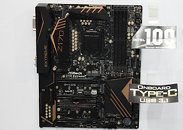Friday, June 5th 2015

ASRock Z170 Extreme7 Motherboard Pictured Up Close
Here's one of the first pictures of ASRock's flagship socket LGA1151 motherboards from its mainline Z170 Extreme series, the Z170 Extreme7. This board offers an exhaustive feature set, and should appeal to gamers and overclockers alike. The board draws power from a combination of 24-pin ATX, 8-pin EPS, with no other auxiliary inputs. The LGA1151 socket is wired to four DDR4 DIMM slots, supporting up to 64 GB of dual-channel DDR4-3200 MHz memory; and three PCI-Express 3.0 x16 slots (x16/NC/NC or x8/x8/NC or x8/x4/x4); the fourth PCIe x16 slot is electrical x4, wired to the PCH. There's also an mPCIe slot; which will seat a WLAN+Bluetooth card on the /ac variant of this board.
The Z170 Extreme7 is the first motherboard to feature three M.2 slots, all three of which are PCIe gen 3.0 x4 (32 Gb/s). Other storage options include three SATA-Express 16 Gb/s, and ten SATA 6 Gb/s ports. The board features two USB 3.1 ports, one each of Type-C and Type-A; and eight USB 3.0 ports, four on the rear panel, four by headers. Display outputs include one each of dual-link DVI, HDMI 2.0 and DisplayPort 1.2. The onboard audio is an ASRock designed Purity Sound III solution, which combines a Realtek ALC1150 CODEC with ground-layer isolation, a headphones amp, and audio-grade capacitors. Other features include dual-BIOS (manual switching), and a high-quality plastic sheath running along its I/O area.
The Z170 Extreme7 is the first motherboard to feature three M.2 slots, all three of which are PCIe gen 3.0 x4 (32 Gb/s). Other storage options include three SATA-Express 16 Gb/s, and ten SATA 6 Gb/s ports. The board features two USB 3.1 ports, one each of Type-C and Type-A; and eight USB 3.0 ports, four on the rear panel, four by headers. Display outputs include one each of dual-link DVI, HDMI 2.0 and DisplayPort 1.2. The onboard audio is an ASRock designed Purity Sound III solution, which combines a Realtek ALC1150 CODEC with ground-layer isolation, a headphones amp, and audio-grade capacitors. Other features include dual-BIOS (manual switching), and a high-quality plastic sheath running along its I/O area.

24 Comments on ASRock Z170 Extreme7 Motherboard Pictured Up Close
Why won't they learn that ancient crap needs to be phased out already... I don't think they make that much of a profit selling high-end boards to people with pre-historic monitors. I mean no one in their right mind will buy this and use the DVI port...
There are lots of people still using DVI, there is nothing wrong with it.
To me it just doesn't make any sense.
See, in the real world, we have mortgages, raise families, pay car payments, insurance, and every other bill under the sun. Gpu's or motherboards rate far higher to upgrade with the limited funds remaining, because they get outclassed. if a monitor is still very good, it's connection plug is NOT a reason to upgrade.
DVI is a perfectly acceptable digital standard. Murdering VGA makes sense, its analogue. DVI however doesn't because it's digital. It's not like it's bad quality or anything, it can support resolutions up to 1600p. For most people this is ample.
I also know an awful lot of people with Z97 boards and i5s and i7s that have zero need for a dedicated GPU. Most offices with high CPU requirements run these kinds of setups, and a fair amount of them use two monitors. As such, that's why motherboards have HDMI + DVI output ports, as well as a DP output. Some people run three monitors, and intel's iGPUs support that. Hell. The guy that's sat next to me in my office is running an i5 and a Z board without a dedicated GPU. He encodes videos all day and uses a multimonitor setup using DVI + HDMI. All makes sense to me.
We have to decide what will benefit and what is possible. There is no PLX chip which allows us to expand and many options are shared on PCH.Chipset brings some new opportunities and this is mainly in the conductivity of the memory elements. (DDR4, SAS. M.2 .SATA e .USB3.1..)only offer is bad in these new standerd ,is too expensive for the normal buyer.
DVI needs to go not because it is limited in functionality, but because it takes up a massive amount of space on the motherboard's IO panel. You can fit 4 USB ports in the amount of space a DVI connector takes, which is a far better use of that space.
I upgrade what needs upgrading when I have money. Which means, I and most of the real world he apparently doesn't live in have to make hard choices about equipment upgrades. A high quality monitor which is operating perfectly but happens to have a DVI connector is NOT a reason to upgrade.
When it dies, or I need a different resolution, of course I will buy a DP monitor.
Though, I will say I'd rather see two HDMI ports, which will fit in the same space as a single DVI.
I suppose it will happen one day.
But thanks for calling me clueless.
Proper M.2 slots ... USB-C present ... now only why there is Thunderbolt 3.0 missing?and you mean "the people" who use this board will use integrated GPU and the motherboard ports in the first place? Even if they do, DVI is still good to have... plenty of not so outdated good monitors use DVI.
How is company supposed to make a decision when buying a new hardware when companies are not sure about their future plans for hardware support and make false predictions?This depends on the reseller but generally Z motherboard if not discounted costs more.